Resources
 Hugh Sweatman (AIMS); History and status of crown-of-thorns starfish on the GBR; Wednesday 8th May 2013.
Hugh Sweatman (AIMS); History and status of crown-of-thorns starfish on the GBR; Wednesday 8th May 2013.
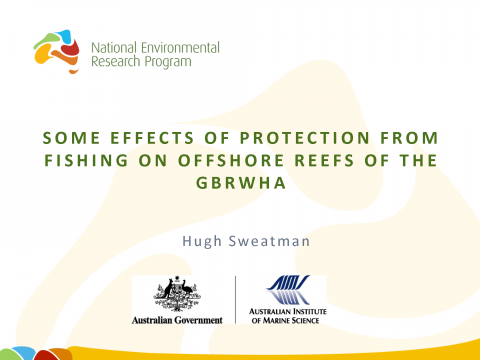 Hugh Sweatman (AIMS); Some effects of protection from fishing on offshore reefs of the GBRWHA; Thursday 6th November.
Hugh Sweatman (AIMS); Some effects of protection from fishing on offshore reefs of the GBRWHA; Thursday 6th November.
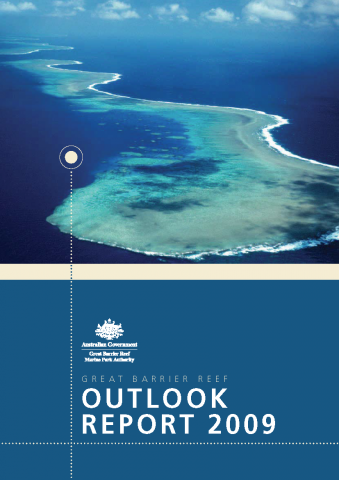 The Great Barrier Reef Outlook Report 2009 is a stock-take of the Great Barrier Reef, its management and its future.
The Great Barrier Reef Outlook Report 2009 is a stock-take of the Great Barrier Reef, its management and its future.
The aim of the Outlook Report is to provide information about:
- The condition of the ecosystem of the Great Barrier Reef Region (including the ecosystem outside the Region where it affects the Region);
• Social and economic factors influencing the Great Barrier Reef ecosystem;
• Management effectiveness of the Great Barrier Reef; and
• Risk-based assessment of the long-term outlook for the Region.
The Report underpins decision-making for the long term protection of the Great Barrier Reef. It was prepared by the GBRMPA based on the best available information and was independently peer reviewed. Many people contributed to the development of the Outlook Report including:
• Australian and Queensland Government agencies
• Leading Great Barrier Reef scientists and researchers
• Industry representatives
• Advisory committees
• Members of regional communities and the public.
The publication of an Outlook Report was a key recommendation of the review of the Great Barrier Reef Marine Park Act 1975. A report is to be prepared every five years and given to the Minister for Sustainability, Environment, Water, Population and Communities for tabling in both houses of the Australian Parliament.
The Great Barrier Reef Outlook Report 2009 is the first of these reports.
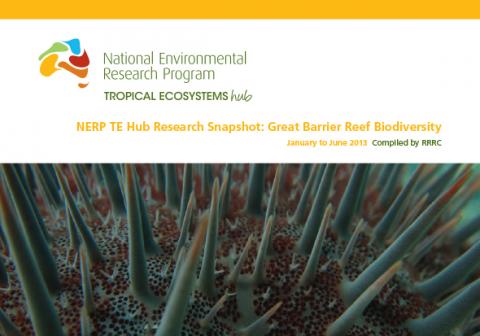 A snapshot of the research progress within the Great Barrier Reef Biodiversity node for January to June 2013.
A snapshot of the research progress within the Great Barrier Reef Biodiversity node for January to June 2013.
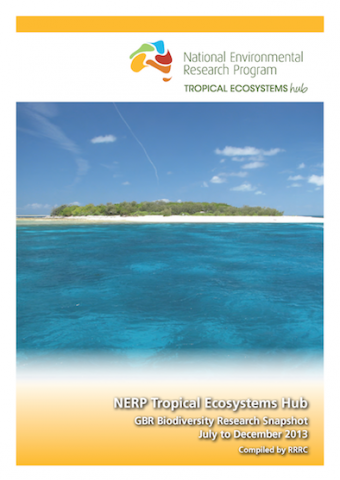 A snapshot of the research progress within the Great Barrier Reef Biodiversity node for July to December 2013.
A snapshot of the research progress within the Great Barrier Reef Biodiversity node for July to December 2013.

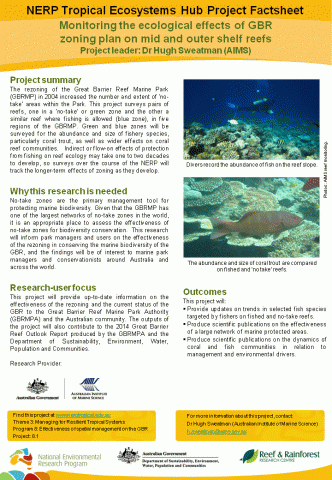 The rezoning of the Great Barrier Reef Marine Park (GBRMP) in 2004 increased the number and extent of ‘no-take’ areas within the Park. This project surveys pairs of reefs, one in a ‘no-take’ or green zone and the other a similar reef where fishing is allowed (blue zone), in five regions of the GBRMP. Green and blue zones will be surveyed for the abundance and size of fishery species, particularly coral trout, as well as wider effects on coral reef communities. Indirect or flow-on effects of protection from fishing on reef ecology may take one to two decades to develop, so surveys over the course of the NERP will track the longer-term effects of zoning as they develop.
The rezoning of the Great Barrier Reef Marine Park (GBRMP) in 2004 increased the number and extent of ‘no-take’ areas within the Park. This project surveys pairs of reefs, one in a ‘no-take’ or green zone and the other a similar reef where fishing is allowed (blue zone), in five regions of the GBRMP. Green and blue zones will be surveyed for the abundance and size of fishery species, particularly coral trout, as well as wider effects on coral reef communities. Indirect or flow-on effects of protection from fishing on reef ecology may take one to two decades to develop, so surveys over the course of the NERP will track the longer-term effects of zoning as they develop.
Johns, K.A., Osborne, K.O., Logan, M. (2014) Contrasting rates of coral recovery and reassembly in coral communities on the Great Barrier Reef. Coral Reefs. [doi:10.1007/s00338-014-1148-z].

Miller, I.R., Logan, M., Johns, K.A., Jonker, M.J., Osborne, K., Sweatman, H.P.A. (2013) Determining background levels and defining outbreaks of crustose coralline algae disease on the Great Barrier Reef. Marine and Freshwater Research. 64(11), 1022-1028.

Cheal, A.J., Emslie, M., MacNeil, M.A., Miller, I., Sweatman, H. (2013) Spatial variation in the functional characteristics of herbivorous fish communities and the resilience of coral reefs. Ecological Applications. 23(1), 174-188 [doi:10.1890/11-2253.1].



